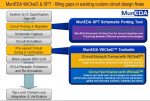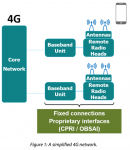Last week whilst China started to recover from COVID-19 outbreak, the rest of the world was seriously impacted by the growing number of cases as the number of cases and deaths outside of China grew higher than in China. With the rise, many governments around the world belatedly put in measures to prevent the further spread of the virus, ranging from lock downs to closing borders. This had a serious impact on the whole business world including semiconductors.
Here in South East Asia, on Monday evening, Malaysia announced it was implementing a Movement Control Order effective from March 18th until March 31st. This would restrict the entry of non Malaysians into the country, and prevented Malaysians from travelling outside of the country as well as restricted movement within the country, to prevent the spread of the virus. The order also instructed the shutdown all but essential businesses to close, amongst other measures. This affected the semiconductor industry in both Malaysia and Singapore.
Initially the semiconductor industry was not on the essential industry list for Malaysia, and so companies prepared to shutdown by Wednesday 18th. Then just before midnight on the 17th, the government added electronics and semiconductors to the essential industry list but companies were only allowed to operate with minimum workforce, so companies scrambled to restart operations, and get the workforce back though not with a full workforce.
The order also impacted Singapore’s semiconductor industry as over 300,000 Malaysians cross the border every day to work in Singapore, many of whom work in the semiconductor industry. On Tuesday when workers arrived at work, they were told to go home and pack for 2 weeks and come back before midnight whilst companies scrambled to find accommodation for the workers for 2 weeks. This caused huge jams on the Causeway. Whilst not all could arrange or not all employees wanted or could stay in Singapore most companies managed to secure enough workforce to maintain production.
Whilst the rest of the world goes into lock down, China is slowly opening up again from it’s lockdown. Xiaomi announced that 80% of it’s supply chain is operational ahead of it’s new 5G phone launch. Also Hon Hai (Foxconn), one of Apples main suppliers, is reported to have begun re-opening it’s factories in Wuhan, after it received approval from the local government.
Whilst China is recovering, and reporting zero local cases, there are still a lot of precautions being taken in China to prevent the re-occurrence of the virus, and the Chinese are taking these in their stride.
Elsewhere in Asia, Taiwan, Singapore and Hong Kong have managed to so far “contain” the outbreak by implementing the lessons learnt from SARS. All the countries started to put in place measures from mid January and although the countries are seeing an increase in the number of cases, most of these are imported and so far have managed to keep the number of new cases per day to double digits, unlike many other countries around the world which are seeing exponential rises.
In Taiwan they are using big data to help contain the outbreak, they have linked their health insurance service the immigration data so they know where people have travelled, and they have fixed the price of face masks and people use their insurance cards to buy their allowance from allocated pharmacies across the island, who can check if the person has used their allowance nad also where they have travelled. As a result most people have access to face masks and most people working in companies wear them all the time at work and outside. Despite these precautions it can not totally stop the spread, TSMC reported that one of their workers was infected this week and they quarantined their co-workers.
In Singapore the government raised the alert level to DORSCON Orange very early on February 7th after just 29 cases were reported, this caused fear amongst it’s neighbouring counties that Singapore was a danger country but by raising the level so early they have prevented the numbers to grow exponentially so far. Singapore has been diligently following a process of contact tracing for every person affected by the virus, to track down and quarantine people that they have been in contact with. Over 5000 people have been quarantined to date, many of them already released without catching the disease. They also have been strictly enforcing restrictions and have imposed severe penalties on those and their employers that break the restrictions. Here is an article from the BBC that explains the level of detail that Singapore goes through to contain the virus.
The impact on the economy is forecast to be very severe. Market research company IDC has evaluated various scenarios based on how long the outbreak lasts as to the impact on the world semiconductor market. They say there is a 80% chance that the market will contract in 2020 compared to 2019 instead og the previously expected growth. The most likely scenario is that world semiconductor market revenue will decrease -6% in 2020.
Whilst SEMI has published a blog on the latest market indicators which are generally already pointing down.
Over 150 companies have reported earning hit due to COVID-19 many of which are semiconductor and electronics companies.
Mobile phone sales in February are reported to have collapsed -38% yoy dropping from 99.2million a year ago to only 61.8million in Feb 2020. With Samsung reporting slow initial sales of it’s newly launched S20 flagship phone. Samsung have told shareholders that the coronavirus pandemic would hurt sales of smartphones and consumer electronics this year, while demand from data centers would fuel a recovery in memory chip markets.
Sales in the auto industry have also been badly hit and now car manufacturing plants around the world are shutting down as supply chains dry up, with all the major automakers in US and Europe declaring temporary shutdowns and halt production. This doesn’t bode well for those companies that rely on the automotive market.
With so many people working from home there are many warnings out about the dangers of hackers seeking to take advantage and infiltrate companies during this outbreak. At Cisco the numbers of security support requests to support remote workforces have jumped 10x in the last few weeks.
Business is business and keeps economy afloat but without healthy workers there is no business, so please do follow all the restrictions to stop the spread not just to the letter of the law but also follow the spirit behind the restrictions. Yes the restrictions can put some temporary hardships on your life but if we all follow them then we can beat this virus, it’s better than ignoring them and having worse consequences. This is a good video explaining the need for social distancing, and how by following it can help avoid deaths. With all the advice to stop touching your face, you still touch it. Here is an video by the BBC that explains the reasons why we touch our face and gives ideas how to stop yourself. Also here is a simple guide to the COVID-19 symptoms and how to prevent catching and spreading the disease.
So please stay safe out there and behave as if you already have symptoms even if you feel fine. Let’s not spread this virus and together we can beat it.









